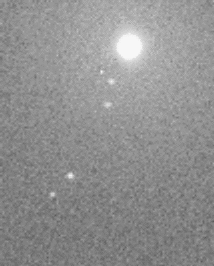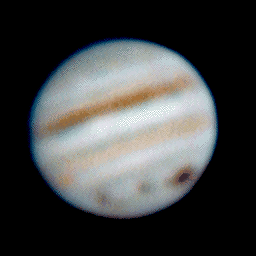|
----------------- a work of fiction Jupiter moons ----------------- to Galileo
|
|
|
|
|
|
||
|
----------------- a work of fiction Jupiter moons ----------------- to Galileo
|
|
"Long-period" cometsIn another section, dealing with Kepler's laws, orbits due to the gravity of a central object were shown to belong to one of three classes:
Now and then (so the common belief holds) a passing star nudges one of these objects sunwards, and after a very long time, it reaches the Sun's vicinity. The Sun evaporates material from the comet and a glowing envelope or "coma" ("hair") forms (comet means "hairy one"). Near the Sun the pressure of sunlight and of the solar wind "blow" the outermost part of the coma into a glowing tail, which--since the force extending it comes from the Sun--generally extends outwards from the Sun, whether the comet is approaching the Sun or receding from it. Very few comets actually hit the Sun--in fact only after satellite images became available have such impacts been observed. In general the "sidewise velocity" (or angular momentum, to use a scientific term) is sufficient so that even if the comet comes close to the Sun (a "sungrazer") it ultimately performs a hairpin turn and returns to far space. Careful observations of comet tails--for example, of comet Hale-Bopp in 1997-- often show two tails with slightly different directions and slightly different colors, too. The (usually) brighter tail points consists of dust pushed (as Kepler had already guessed) by the pressure of sunlight. Its glow is scattered sunlight and its spectrum resembles the Sun's. The other tail is driven by the solar wind, a constant stream of charged particles, driven at about 400 km/sec (average) by the million-degree heat of the solar corona, the outermost layer of the Sun. As its light shows, such a tail consists of ions, atoms of the coma which were stripped by sunlight of one or more electrons. The solar wind consists of ions too, and in fact, the existence of an ion tail was the first strong evidence for the existence of a "solar corpuscular radiation" as the solar wind was then called, proposed in Germany by Cuno Hoffmeister and later by Ludwig Biermann. The solar wind and the ion tail are both so rarefied that collisions between their particles hardly ever occur. However, the solar wind arises among the Sun's magnetic field lines, and the interaction between moving plasma and a magnetic field creates electric fields and currents (note: in a collision-free plasma, electric curents just shape the magnetic field and do not involve ohmic resistivity). These can modify the flow (if the particles are sufficiently rarefied) or else, deform the field lines (if they are not, as is the case in the solar wind). The point to note is that, when the electric field caused by that interaction of flowing plasma and magnetig field lines reaches ions blown off the comet, it picks them up and carries them along with the solar wind. The solar wind flows away from the Sun at something like 400 km/sec, but meanwhile the source, the comet itself, may be moving at 20-50 km/sec. The chain of particles emitted into the ion tail during a certain second then extends 400 km radially from the Sun, but since those particles had started at points 20-50 km apart on the comet's trajectory, the line they form is not quite radial, not necessarily the same as the direction of the tail pushed by sunlight Periodic comets and "Centaurs"In addition, however, there exist many periodic orbits , some with a period of less than 10 years. Halley's comet, perhaps the best known, has a period of 75 years and reaches its greatest distance just beyond the orbit of Neptune. Comets were aptly called "dirty snowballs" by Fred Whipple, and sunlight erodes them constantly, helped by the solar wind. On a near-solar orbit they are not expected to last very long--not even Halley's comet, though it spends most of its time at great distances where sunlight causes little heating. Gradually all volatile material such as ice evaporates, the showy tail thins out and disappears, and all that's left of the comet are grains of rocky stuff which gradually disperse along its orbit. When Earth crosses such an orbit, many such grains hit the atmosphere and because of their high velocity, are vaporized by air resistance, emitting a brief bright glow. These are "meteors" [Note: meteorites are the objects which hit the atmosphere and sometimes even reach ground, while meteors are the flashes or streaks in the sky]. Several "meteorite showers" recur annually, and are believed to mark the crossing of the orbits of former comets. An example of comet decay has actually been recorded. Biela's comet was first seen in 1772, and Biela in 1826 calculated its period as 6.6 years. In 1846 it was observed to have broken in two, in 1852 the gap between the fragments was larger, and it was expected to be seen again in 1859, 1865 and 1872, but was not. Instead in 1872 a brilliant meteor shower was seen when Earth crossed the orbit. It recurred in subsequent years, but gradually grew fainter.  Sometimes the end of a comet is more spectacular. In March 1993, Carolyn and Eugene Shoemaker together with David Levy observed a strange string of objects orbiting Jupiter (see image on the right, taken after the first impact). From the orbit it was later deduced that these were probably fragments of a comet's pass near the planet about a year earlier. Because of the relative motion of the two objects, the comet not only broke, but its fragments were captured by the gravity of Jupiter in a very elliptical orbit, which the discoverers expected to intersect the planet in July 1994. Astronomers tried to observe the collisions themselves, but these occurred just behind the visible edge of the planet; however, when Jupiter's rotation brought the impact locations into view, they were easily identified by dark blotches in Jupiter's atmosphere (image below, right). It has been suggested that chains of craters on the Moon also arose from objects which broke up before impact.
Sometimes the end of a comet is more spectacular. In March 1993, Carolyn and Eugene Shoemaker together with David Levy observed a strange string of objects orbiting Jupiter (see image on the right, taken after the first impact). From the orbit it was later deduced that these were probably fragments of a comet's pass near the planet about a year earlier. Because of the relative motion of the two objects, the comet not only broke, but its fragments were captured by the gravity of Jupiter in a very elliptical orbit, which the discoverers expected to intersect the planet in July 1994. Astronomers tried to observe the collisions themselves, but these occurred just behind the visible edge of the planet; however, when Jupiter's rotation brought the impact locations into view, they were easily identified by dark blotches in Jupiter's atmosphere (image below, right). It has been suggested that chains of craters on the Moon also arose from objects which broke up before impact.
 Much of what follows below is based on the article "The Kuiper Belt" by Jane Luu and David Jewitt, the discoverers of 1992 QB1, the first Kuiper belt object observed apart from Pluto ("Scientific American" May 1996, p. 47-52). Please bear in mind, however, that future studies may well change some of this picture.
Much of what follows below is based on the article "The Kuiper Belt" by Jane Luu and David Jewitt, the discoverers of 1992 QB1, the first Kuiper belt object observed apart from Pluto ("Scientific American" May 1996, p. 47-52). Please bear in mind, however, that future studies may well change some of this picture.
For many years common wisdom had it that short-term comets were produced when long-term comets passed near a large planet, lost energy (by the process described here) and were deflected into short-period orbits. That is quite possible (though such an encounter could also add energy and throw the comet nucleus out of the solar system altogether). Studies have however shown that given the scarcity of long-term comets, too many short-term comets exist to be explained by such a process. On 1 November 1977 Charles Kowal discovered what seemed to be a large asteroid between Saturn and Uranus. It was named Chiron, after a centaur in Greek mythology (half human, half horse--an apt name for a strange object!). Ultimately Chiron was found to be more comet-like--a nucleus of 150-200 km surrounded by a dust coma, which made it look larger, and in an orbit ranging from 8.5 to 19 astronomical units. On a long time-scale such an orbit will not be stable--it can pass close to a large planet and by the gravity-assist mechanism, either lose speed and shift sunward, or gain speed and perhaps leave the solar system altogether. Since then many other objects of this class have been observed, and they are known as centaurs. They apparently come from the Kuiper belt, whose orbits (on the long term, especially innermost ones) can be modified by Neptune's gravity and become quite eccentric, as has been demonstrated by orbital simulations on a computer. However, eccentric orbits are likely to be perturbed again by large planets, and some ultimately become the source of short period comets. In a class by itself (so far) is Sedna, a large object (1000 km or more) discovered January 2005 at a distance of 97 AU, its orbit stretching between 76 AU of the Sun (perihelion) to perhaps 1300 AU (aphelion). That range bridges the gap between the Kuiper belt and the Oort cloud, and no one can as yet give a convincing explanation for Sedna's existence, or estimate how many other such distant objects may exist. One explanation suggests that Sedna owes its existence to an object outside the solar system. The Solar WindBecause the solar wind moves faster than the "Alfvén velocity" whose role is somewhat analogous to the speed of sound in the atmosphere, the first sign of the interstellar obstacle is a shock transition, the termination shock, crossed by Voyager 1 on December 15 2004 and by Voyager 2 on 30 August 2007. Past that shock the flow is slower ("sub-alfvénic") and denser, and the magnetic field is stronger too (though with Voyager 2, the slowing down was less pronounced than expected). But the flow still expands with distance, which reduces its density and field still more, ultimately causing it to stop expanding, at a boundary termed heliopause. As of 2008, the heliopause has not yet been reached and we are unsure of its properties, except that it is expected to have a front on one side and a long tail on the other, due to the motion of the solar system through interstellar space. Tidbit:Even without telescope, a good pair of prism binoculars (6 x 35 or 7 x 50) will show you many sky details too faint and small for the unaided eye--for instance, they help observe comets.Many years ago I listened to the astronomer (also poet) Desmond King-Hele review our knowledge about comets. He ended with impressive images of telescopes used to study comets, and then switched to his last slide, a man reclining in a folding garden chair and scanning the sky with binoculars. "Many good observations can be made with no more than simple equipment. Look for instance at this observer. You may say he is
While lying doggo in a deck chair Oh what a way to end a lecture! " |
This is the last page in the unit on solar system planets
Next Stop: #9c The Discovery of the Solar System, from Copernicus to Galileo
Timeline Glossary Back to the Master List
Author and Curator: Dr. David P. Stern
Mail to Dr.Stern: stargaze("at" symbol)phy6.org .
Last updated: 27 February 2008